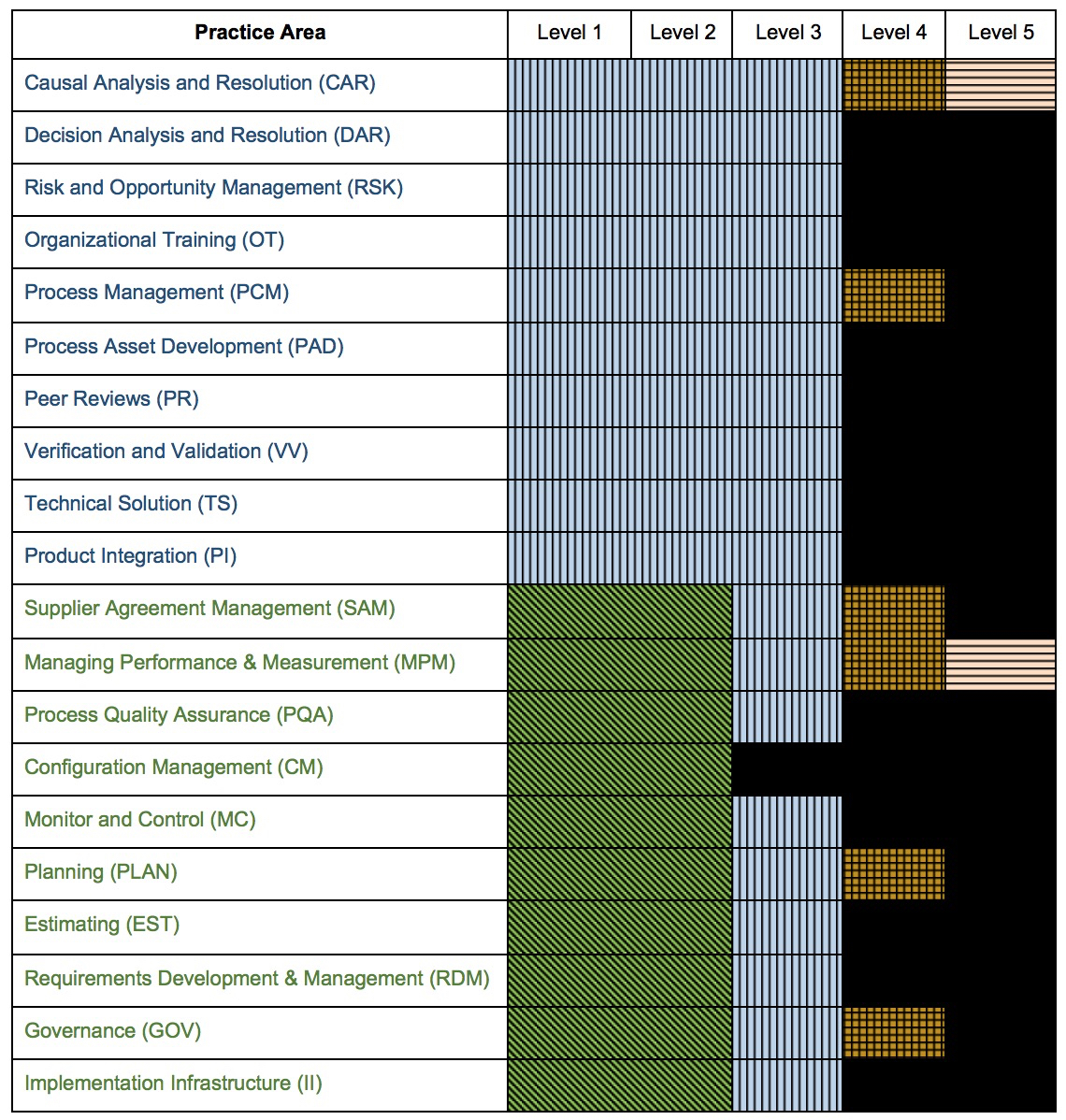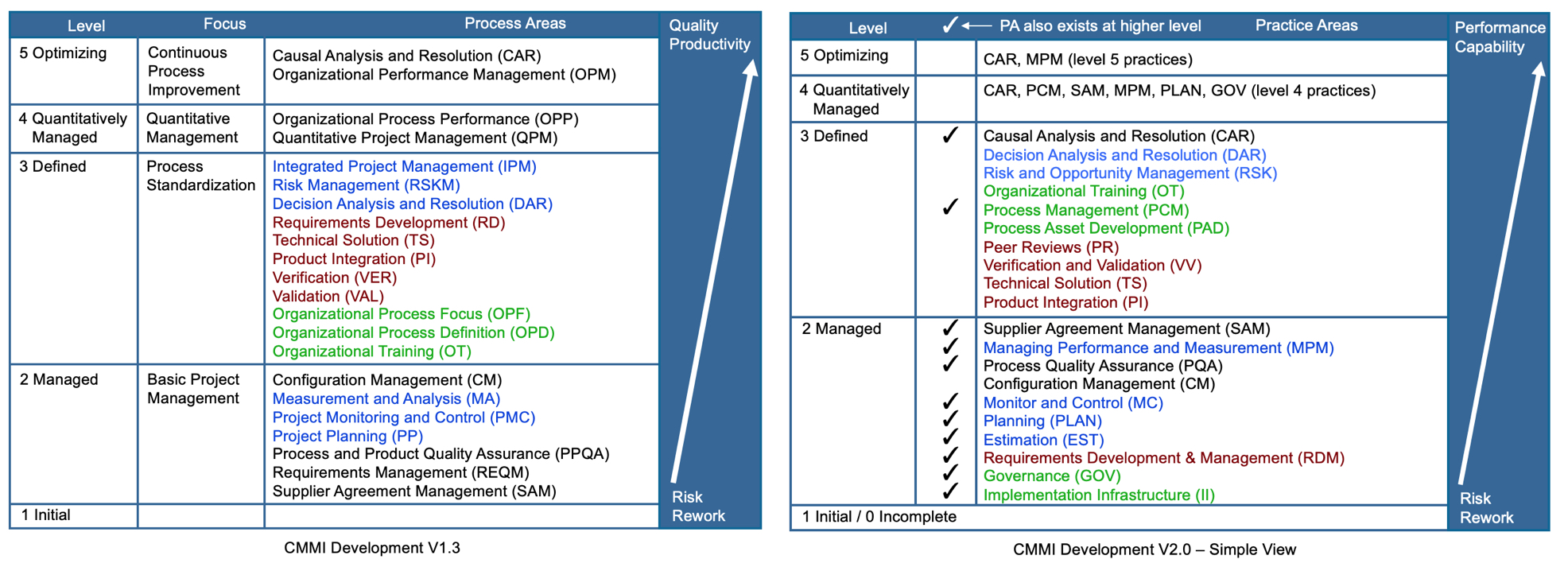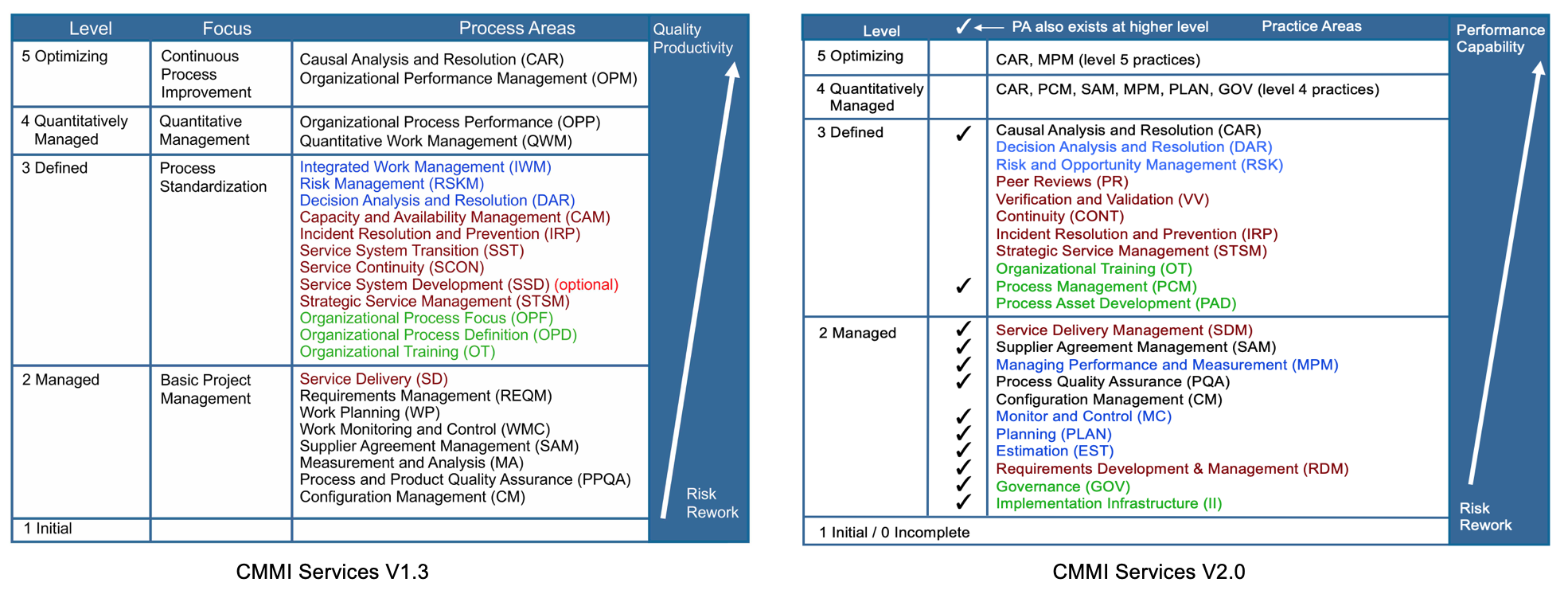Introduction
(Updated 11/4/19)
In March 2018, a new version of the Capability Maturity Model Integration (CMMI) and appraisal method were released. This article summarizes the changes and upcoming milestones.
The overall focus in V2.0 has been to drive home the point that the model is about improving organizational capability to improve performance for any type of work (Agile, Waterfall, services, or a hybrid).
Figure 1: CMMI V2.0 — click on image to make larger
Goals and Motivation for Version 2.0
The CMMI Institute has focused on simplifying both the model and appraisal method. Here are some of their original goals for the changes:
Model
- A simplified model that reduces redundancy.
- One model that includes Development, Services, Security, Supply Chain and People practices. Appropriate topics are selected for different types of organizations.
- Each Practice Area contains an evolutionary pathway (e.g., Capability Level 1, 2 and 3 practices).
Appraisal Method
- Increase quality, reliability, and consistency.
- Reduce the overall lifecycle cost to conduct an appraisal.
- Minimize organizational and work effort disruption.
- Provide greater insight into performance improvement.
The main communication points from the CMMI Institute for V2.0 are:
- Improve Business Performance: Business goals are tied to operations in order to drive measurable improved performance.
- Leverage Current Best Practices: CMMI V2.0 is a trusted source of proven best practices.
- Build Agile Resiliency and Scale: The model contains direct guidance on how to strengthen Agile with Scrum.
- Benchmark Capability and Performance: The new performance-oriented appraisal method improves the reliability and consistency of benchmarking while reducing preparation time and lifecycle costs.
- Accelerate Adoption: Online platform and adoption guidance make the benefits of CMMI more rapidly achievable.
- Changed “Process Area” to “Practice Area”: This emphasizes that the model is not a collection of (rote) processes to be implemented, but a collection of practices to be used to run and manage projects.
- Organized practices within each Practice Area: Practices are organized by levels instead of Specific Goals. Levels provide a clear, methodical path for building capability and improving performance within each Practice Area.
- Replaced the Generic Practices with two new Practice Areas: Governance (GOV) & Implementation Infrastructure (II) to reduce the redundancy and complexity of the Generic Practices. They foster the persistence and habit of an organization’s processes and their business value rather than compliance to the model.
Major Model Changes
The new layout includes levels (similar to the old Capability Levels) that provide a simple process maturity pathway. For example, to be Maturity Level 3 (ML3), Practice groups at Levels 1, 2 and 3 (the “Level” columns in Figure 2) have to be satisfied.
Maturity Levels
Figures 2a and 2b show the new structure of the Development and Services models. The Practice Areas for each Maturity Level are:
- Maturity Level 2 = Green colored Practice Areas, each implemented with Level 1 and Level 2 practices.
- Maturity Level 3 = Maturity Level 2 + blue Practice Areas implemented with Level 1, Level 2, and Level 3 practices.
- Maturity Level 4 = Maturity Level 3 + dark brown CAR, PCM, SAM, MPM, PLAN, and GOV Level 4 practices.
- Maturity Level 5 = Maturity Level 4 + light brown CAR, and MPM Level 5 practices.
- Supplier Agreement Management (SAM) can be declared Not Applicable if there are no suppliers (same as CMMI V1.3).
Figure 2a: CMMI V2.0 Practice Areas — Development View
Figure 2b: CMMI V2.0 Practice Areas — Services View
A free summary of the model (CMMI V2.0 Quick Reference Guide) is at the link cmmiinstitute.com/resources/. You will have to create an account.
New and Changed Practices
Here is our (unofficial) summary comparison of the two models:
Below we summarize the significant practice changes in V2.0. Note that the wording of many practices has changed, and some have moved to different areas of the model. For example, if your organization is targeting Maturity Level 2, some of the old ML3 practices have now moved to ML2. We have left out Level 1 practices since they are assumed to be performed if Level 2 practices are performed.
CMMI V2.0 Additions to ML2
There are seven new practices and one changed practice (see change in red text).
Requirements Development and Management (RDM)
- 2.1: Elicit stakeholder needs, expectations, constraints, and interfaces or connections.
- 2.2: Transform stakeholder needs, expectations, constraints, and interfaces or connections into prioritized customer requirements.
Planning (PLAN)
- 2.1: Develop and keep updated the approach for accomplishing the work.
- 2.5: Plan transition to operations and support.
Monitor and Control (MC)
- 2.3: Monitor the transition to operations and support.
Process Quality Assurance (PQA)
- 2.1: Develop, keep updated, and follow a quality assurance approach and plan based on historical quality data.
Supplier Agreement Management (SAM)
- 2.4: Manage invoices submitted by the supplier according to the supplier agreements.
CMMI V2.0 Deletions from ML2
- SAM SP 1.1: Determine the type of acquisition for each product or product component to be acquired.
- SAM SP 1.2: Select suppliers based on an evaluation of their ability to meet the specified requirements and established criteria.
These SAM practices have moved to the optional Suppler Source Selection Practice Area.
Project Planning (PP / WP)
- PP SP 2.2: Identify and analyze risks.
[Note: although the practice is now in the ML3 RSK PA, risk is still included in the Required Intent PA information in PLAN at ML2, so risk management is still at ML2.
Project Monitoring And Control (PMC / WMC)
- PMC SP 1.3: Monitor risks against those identified in the project plan.
[Note: the practice is now in the ML3 RSK PA, and there is nothing mentioned in the Required Intent PA information in MC at ML2, so risk monitoring is not in ML2. However, it is very useful and trivial to do.
CMMI V2.0 Additions to ML3
Requirements Development and Management (RDM)
RDM was not in the v1.3 of the Services model, so these practices are new to Service organizations.
- 3.2: Develop operational concepts and scenarios.
- 3.3: Allocate the requirements to be implemented.
- 3.4: Identify, develop, and keep updated interface or connection requirements.
- 3.5: Ensure that requirements are necessary and sufficient.
- 3.6: Balance stakeholder needs and constraints.
- 3.7: Validate requirements to ensure the resulting solution will perform as intended in the target environment.
Monitor and Control (MC)
- 3.3: Monitor the work environment to identify issues.
Managing Performance and Measurement (MPM)
- 3.1: Develop, keep updated, and use organizational measurement and performance objectives traceable to business objectives.
- 3.3: Develop, keep updated, and follow a data quality process.
Supplier Agreement Management (SAM)
- 3.1: Select technical supplier deliverables for analysis and conduct technical reviews.
- 3.2: Select and monitor supplier processes and deliverables based on criteria in the supplier agreement.
Process Asset Development (PAD)
- 2.2: Develop, buy, or reuse process assets.
- 3.2: Develop, record, and keep updated a process architecture that describes the structure of the organization’s processes and process assets.
- 3.7: Develop, keep updated, and make organizational measurement and analysis standards available for use.
Decision Analysis and Resolution (DAR)
- 3.1: Develop, keep updated, and use a description of role-based decision authority.
Causal Analysis and Resolution (CAR)
- 2.1: Select outcomes for analysis.
- 2.2: Analyze and address causes of outcomes.
- 3.1: Determine root causes of selected outcomes by following an organizational process.
- 3.2: Propose actions to address identified root causes.
- 3.3: Implement selected action proposals.
- 3.4: Record root cause analysis and resolution data.
- 3.5: Submit improvement proposals for changes proven to be effective.
CMMI V2.0 Deletions from ML3
- OPD SP 1.2: Establish and maintain descriptions of lifecycle models approved for use in the organization.
- OPD SP 1.7: Establish and maintain organizational rules and guidelines for the structure, formation, and operation of teams.
The new Value statement in the model text, which is listed below each practice, is now a required part of the model. The appraisal team has to make sure that the value statement (intent) of each practice is being met. To quote the appraisal method, “The intent of each practice is collectively: the practice statement, the value statement, and the additional required information.”
CMMI V2.0 Levels 4 and 5
The practices in maturity levels 4 and 5 are similar to CMMI V1.3, but they have all shifted around. Assume for now that your Lead Appraiser will explain this.
Generic Practice Changes
The old Generic Practices have been replaced by two new Practice Areas, Implementation Infrastructure (II) and Governance (GOV). Now they are applied and appraised against your processes, rather than being appraised against each Process Area in V1.3.
We will write more about these in a later article.
Implementation Infrastructure (II)
II makes sure processes are performed, similar to the previous Generic Practices.
- 2.1 Provide sufficient resources, funding, and training for developing processes.
- 2.2 Develop and keep processes updated, and verify they are being followed.
- 3.1 Use organizational processes and process assets to plan, manage, and perform the work.
- 3.2 Evaluate the adherence to and effectiveness of the organizational processes.
- 3.3 Contribute process-related information or process assets to the organization.
Governance (GOV)
GOV makes sure that senior management actively leads the way. It replaces the more passive Generic Practice 2.10.
- 2.1 Senior management defines, keeps updated, and communicates organizational directives for process implementation and improvement based on organization needs and objectives.
- 2.2 Senior management ensures resources are provided for developing, supporting, performing, improving, and evaluating adherence to expected processes.
- 2.3 Senior management identifies their information needs, and uses the collected information to provide governance and oversight of effective process implementation and improvement.
- 2.4 Senior management holds people accountable for adhering to organization directives and achieving process implementation and improvement objectives.
- 3.1 Senior management ensures that measures supporting objectives throughout the organization are collected, analyzed, and used.
- 3.2 Senior management ensures that competencies and processes are aligned with the objectives of the organization.
- 4. 1 Senior management ensures that selected decisions are driven by statistical and quantitative analysis related to performance and achievement of quality and process performance objectives.
There is an official mapping of practice changes between V1.3 and V2.0. Since it is very long and hard to read, we have created a more concise mapping that we will provide to clients when we deliver upgrade or introductory CMMI training.
Obtaining the Model Document
- The full model text is available for purchase in PDF or Viewer form at cmmiinstitute.com/model-viewer/. The annual Viewer license includes updates as they are published. The one-time PDF purchase does not.
- CMMI V2.0 Quick Reference Guide
- CMMI V2.0 Quick Reference Guide (汉语)
- CMMI V2.0 Adoption and Transition Guidance
- CMMI V2.0 Adoption and Transition Guidance (汉语)
- CMMI V2.0 to V1.3 Practice Mapping
- CMMI V2.0 to V1.3 Practice Mapping (汉语)\
Model Document Pricing (as of August 2018)
All the free documents listed below should be available at cmmiinstitute.com/resources.
- Quick Reference Guide for CMMI Development V2.0: Free.
- Estimation Practice Area – full sample section: Free.
- One-time copy of the full model (price does not cover future updates): $150.
- V1.3 to V2.0 mapping: Free.
- Online web Viewer: $250 per year. If you purchased a copy at the old $450 price, your license will be extended by 7 months.
- Trial Viewer access: $50 for 30 days.
- Three-day CMMI class student Viewer access: The Viewer price is included in the class fee and lasts 30 days.
- Enterprise Viewer license: Enterprise licenses are available in bundles of 10, 25, 50, 100, 150, 200, 250 or unlimited. Seat licenses can be reassigned when people leave the organization. Contact partners@cmmiinstitute.com for quotes.
- Appraisal Method Definition Description (MDD) PDF — $350. (Don’t buy – let your LA tell you what’s in it.)
- Adoption and Transition Guide – Free.
A Lead Appraiser can share a not-for-profit tool copy (e.g., spreadsheet) with a client that contains the model practices without the client needing to purchase a copy of the model. The client must purchase a license before the Lead Appraiser can give a client a copy of the models descriptive text.
Changes in the Appraisal Method
Types of Appraisal
There are three new types of appraisal:
- Benchmark: This replaces the SCAMPI V1.3 Class A (rated) appraisal.
- Evaluation: This replaces the SCAMPI V1.3 Class B and C (informal) appraisals.
- Sustainment: This is a new appraisal type that can be used to extend an organization’s rating for six years (two years at a time based on eligibility criteria).
Three Sustainment appraisals can be performed (once every two years) before a new Benchmark appraisal is required. A Sustainment appraisal is one third the scope of a Benchmark appraisal. There are criteria for eligibility, such as:
- The relevant sampling factors from the previous appraisal have not significantly changed (e.g., type of work, size of organization).
Note: The eligibility criteria of “In-scope projects from the prior Benchmark or Sustainment Appraisal are still active” has been deleted in the latest version of the appraisal method.
Organizational Sampling
The minimum organizational sample will be a random sample generated by the CMMI Institute Appraisal System (CAS). The Lead Appraiser will enter information about the organization’s projects and CAS will respond with a random sample of projects and practices. This random sample is generated a maximum of 60 days in advance of the appraisal “conduct” phase. The Lead Appraiser can (and in our opinion should) sample more than the minimum.
Performance Report
A new performance report is required to be delivered to the sponsor and CMMI Institute for Benchmark and Sustainment appraisals. (It is optional for Evaluation appraisals.) The performance report summarizes the metrics that have improved throughout the CMMI implementation (e.g., increase schedule prediction or reduce rework). The performance report does not impact the rating.
The task of generating the performance report should be started very early in the improvement cycle. The CMMI Institute has an example spreadsheet that can be used. With some clever thinking, the performance report could be the artifact used to demonstrate the Practice Area MPM.
Training for Appraisal Teams
Appraisal team members previously trained under CMMI V1.3 may upgrade their training to CMMI V2.0 through one of the following course formats:
- Partner-led CMMI V2.0 Upgrade Training (1-day, in-person delivery, $300/person + the LA’s labor fee).
- E-learning CMMI V2.0 Upgrade Training (1-day, self-paced online delivery, available starting October 2018, $600/person).
Either course will upgrade the students’ training to CMMI V2.0 for all content areas, including Development, as well as content areas not yet released (e.g., Services, Supplier Management, Security, etc.)
High Maturity Appraisal Team Members (Levels 4 and 5) will also be required to complete the 1-day “High Maturity Concepts” course from a qualified HM Lead Appraiser at $100/person plus the LA’s labor fee. The CMMI Institute expects to develop a self-paced, e-learning format of the “High Maturity Concepts” course, but no delivery date has been established.
Foreign language interpreters
CMMI V2.0 appraisals will require interpreters to be registered with the CMMI Institute. They have to:
- Pass an English test
- Pass the CMMI associate exam
- Pass a verbal exam conducted by CMMI Institute
- Prove that they have an English qualification (e.g., degree)
Transition Dates for V2.0
Below are the main dates when the new model and appraisal method will come into effect:
- CMMI V1.3 appraisals can be conducted until 30 September 2020. The appraisal result will still be valid for three years.
- CMMI V2.0 Development appraisals can be conducted starting January 2019.
- The CMMI V2.0 Security Practice Area will be available 2020.
Conclusion (Neil’s and Mary’s opinion)
If:
- your organization was focused on pragmatic process implementation before,
- all projects were equally process-mature (that is, you didn’t just have one stellar project for the appraisal),
- the CMMI practices were used to run the business (that is, to achieve business goals, address chronic problems, maintain gains and mitigate risks), and
- you had a practical and thoughtful Lead Appraiser you loved,
…then there are only a few implementation items that have changed that you will have to adopt, and many appraisal rules and regulations your LA will have to worry about.
However, if your organization was implementing CMMI with no depth (:<), just barely surviving each appraisal with rote practice implementation (:<), and you had a robotic Lead Appraiser you hated (why?), then many things have changed in V2.0 to ensure your company is focused on results (:>).
Please feel to contact us if you need help improving or navigating CMMI.
[Forward this email to your boss! Subject: Here’s a cool tip for you] Quick Link.





 The Process Group helps you improve your organization's capability to routinely meet deadlines and delivery quality expectations. We are certified CMMI appraisers / trainers and Certified Scrum Masters.
The Process Group helps you improve your organization's capability to routinely meet deadlines and delivery quality expectations. We are certified CMMI appraisers / trainers and Certified Scrum Masters. 